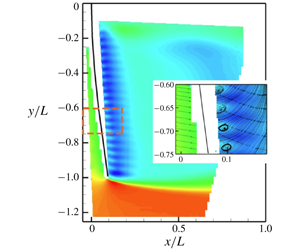Crossref Citations
This article has been cited by the following publications. This list is generated based on data provided by
Crossref.
Pezzulla, M.
Strong, E. F.
Gallaire, F.
and
Reis, P. M.
2020.
Deformation of porous flexible strip in low and moderate Reynolds number flows.
Physical Review Fluids,
Vol. 5,
Issue. 8,
Wu, Yu Kai
Liu, Yan Peng
and
Sun, Mao
2021.
Unsteady aerodynamics of a model bristled wing in rapid acceleration motion.
Physics of Fluids,
Vol. 33,
Issue. 11,
García-Baena, C.
Jiménez-González, J. I.
and
Martínez-Bazán, C.
2021.
Drag reduction of a blunt body through reconfiguration of rear flexible plates.
Physics of Fluids,
Vol. 33,
Issue. 4,
Bhamitipadi Suresh, Dhanush
Aju, Emmanuvel Joseph
Pham, Dat Thanh
and
Jin, Yaqing
2021.
On the incipient sediment suspension downstream of three-dimensional wall-mounted obstacles.
Physics of Fluids,
Vol. 33,
Issue. 8,
Hong, Liu
Cheng, Shyuan
Houseago, Robert C.
Parsons, Daniel R.
Best, James L.
and
Chamorro, Leonardo P.
2022.
On the submerged low-Cauchy-number canopy dynamics under unidirectional flows.
Journal of Fluids and Structures,
Vol. 113,
Issue. ,
p.
103646.
Gong, Pengyao
Aju, Emmanuvel Joseph
and
Jin, Yaqing
2022.
On the aerodynamic loads and flow statistics of airfoil with deformable vortex generators.
Physics of Fluids,
Vol. 34,
Issue. 6,
Marzin, Tom
Le Hay, Kerian
de Langre, Emmanuel
and
Ramananarivo, Sophie
2022.
Flow-induced deformation of kirigami sheets.
Physical Review Fluids,
Vol. 7,
Issue. 2,
Kumar, Vivek
Assam, Ashwani
and
Prabhakaran, Deepu
2023.
Dynamics of a wall-mounted cantilever plate under low Reynolds number transverse flow in a two-dimensional channel.
Physics of Fluids,
Vol. 35,
Issue. 8,
Gong, Pengyao
Bhamitipadi Suresh, Dhanush
and
Jin, Yaqing
2023.
Coupling between vortex flow and whisker sensor in cylinder wakes with time-varying streamwise gaps.
Physical Review Fluids,
Vol. 8,
Issue. 3,
Cheng, Shyuan
Olivieri, Stefano
Rosti, Marco E.
and
Chamorro, Leonardo P.
2023.
Gap-modulated dynamics of flexible plates.
Journal of Fluid Mechanics,
Vol. 974,
Issue. ,
Gomez, Michael
Reis, Pedro M.
and
Audoly, Basile
2023.
Twisting instabilities in elastic ribbons with inhomogeneous pre-stress: A macroscopic analog of thermodynamic phase transition.
Journal of the Mechanics and Physics of Solids,
Vol. 181,
Issue. ,
p.
105420.
Lee, Minhyeong
Mahravan, Ehsan
and
Kim, Daegyoum
2024.
Flow-induced rearrangement of a poroelastic cluster.
Journal of Fluid Mechanics,
Vol. 983,
Issue. ,
Kakroo, Karan
and
Sadat, Hamid
2024.
High-fidelity fluid–structure interaction simulations of perforated elastic vortex generators.
Physics of Fluids,
Vol. 36,
Issue. 11,
Suresh, Dhanush Bhamitipadi
Deng, Qianxi
Palagummi, Saketh
Shores, Jack
and
Jin, Yaqing
2025.
Turbulence and blade deformations of flexible emergent canopies in water flows.
Physics of Fluids,
Vol. 37,
Issue. 8,
You, Hojung
and
Tinoco, Rafael O.
2025.
Characterization of Porous In‐Stream Structures to Assess Their Implications on Flow Dynamics and Sediment Transport.
Journal of Geophysical Research: Earth Surface,
Vol. 130,
Issue. 3,
Kakroo, Karan
and
Sadat, Hamid
2025.
Dynamic behavior of tandem perforated elastic vortex generators using two-way coupled fluid–structure interaction simulations.
Physics of Fluids,
Vol. 37,
Issue. 10,

 $V$, i.e. drag proportional to the
$V$, i.e. drag proportional to the  $(2+V)$ power of the incoming flow velocity. High-resolution force balance, planar particle image velocimetry and particle tracking velocimetry are used to measure the drag force, flow characteristics and plate bending. For a flexible plate with relatively high porosity given by an array of regularly spaced square openings, we derive a simple analytical argument that accounts for the sub-quadratic trends of the drag in a range of flow velocities spanning one order of magnitude. There, the drag experienced by the structure is modulated by the contributions of the local structure containing an open area. The effective approach velocity for each of these sections appears to increase monotonically with increased structure deformation due to the reduced effect of local wakes produced by adjacent areas. The uncovered aerodynamic behaviour may help to understand the complex flow–structure interaction of perforated structures in nature and engineering.
$(2+V)$ power of the incoming flow velocity. High-resolution force balance, planar particle image velocimetry and particle tracking velocimetry are used to measure the drag force, flow characteristics and plate bending. For a flexible plate with relatively high porosity given by an array of regularly spaced square openings, we derive a simple analytical argument that accounts for the sub-quadratic trends of the drag in a range of flow velocities spanning one order of magnitude. There, the drag experienced by the structure is modulated by the contributions of the local structure containing an open area. The effective approach velocity for each of these sections appears to increase monotonically with increased structure deformation due to the reduced effect of local wakes produced by adjacent areas. The uncovered aerodynamic behaviour may help to understand the complex flow–structure interaction of perforated structures in nature and engineering.
